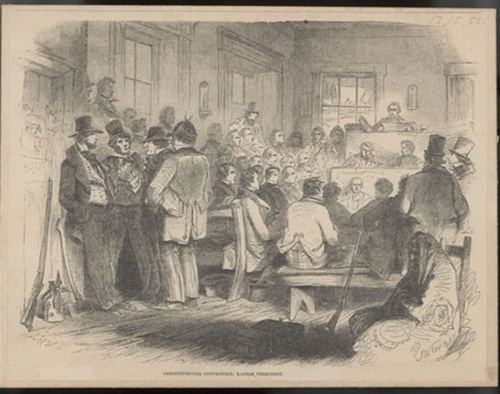 | ||
The Topeka Constitutional Convention met from October 23 to Nov 11, 1855 in Topeka, Kansas Territory at Constitution Hall. It drafted the Topeka Constitution that would have banned slavery in Kansas. The convention was organized by Free-Staters to counter the pro slavery Territorial legislature elected March 5, 1855 in polling suffering widely from electoral fraud and the intimidation of free state settlers.
The Topeka Constitution marked the first effort to form a Kansas governmental structure and define its basis in law. Free-State delegates passed the constitution on December 15, 1855. The Territory-wide election for officers and approval of the constitution on January 15, 1856 was boycotted by most pro slavery men. Among those elected was Charles L. Robinson as governor. The constitution was forwarded to Washington with a plea to the U.S. Congress for its acceptance. President Pierce condemned the document. It was presented in the Senate by Senator Lewis Cass of Michigan and in the House by Representative Daniel of Indiana. It passed the House by two votes on July 2, but was held in committee by the Senate. On July 8, Senator Stephen A. Douglas took up the Topeka Constitution in a bill counter to Senator Cass, which threw the issue back upon the people of Kansas in accordance with the provisions of the Kansas-Nebraska Act. With renewed determination, the Free State legislature reconvened in Topeka's Constitution Hall on January 5, 1858. Governor Robinson urged keeping the State government intact and laws were passed. The Topeka Constitution was once more sent to the Congress, but no action was taken. Three more state constitutions were later proposed: the pro slavery Lecompton Constitution (1857) and the Free-State Leavenworth Constitution (1858,) before the Wyandotte Constitution (1859) ultimately led to Kansas being admitted into the Union as a free state in 1861. The Civil War began four months later.
Citizens of the 2nd Territorial District petitioned the 1855 Free State convention to incorporate a black exclusion clause in the Topeka Constitution. This was rejected by officials including James H, Lane, convention president, who allowed the issue to be voted separately in the January 1856 elections; the results favored exclusion. An outcome would have been prevention of resident free African Americans, as well as the characteristic dangers created by frontier bounty hunters.
The conflict by separate Free State and Territorial legislatures, each seeking control of Kansas' destiny, was carried out with guns and the ballot box. These conditions and surrounding national implications inspired the term Bleeding Kansas. Following the Free State elections, in a lengthy address on January 24, 1856, President Franklin Pierce proclaimed the Topeka government to be revolutionary and ordered the arrest of its leaders: Despite this proclamation, the Topeka Legislature convened on March 4, 1856 and again on the Fourth of July to ask the Congress for admittance of the state. The legislature was dispersed on July 4, 1856 by three squadrons of federal troops under the command of Colonel Edwin Vose Sumner. Sumner later called this the most painful duty of his career. Never before had a body of U.S. citizens, meeting to regain their voting rights, been broken up by federal forces.
